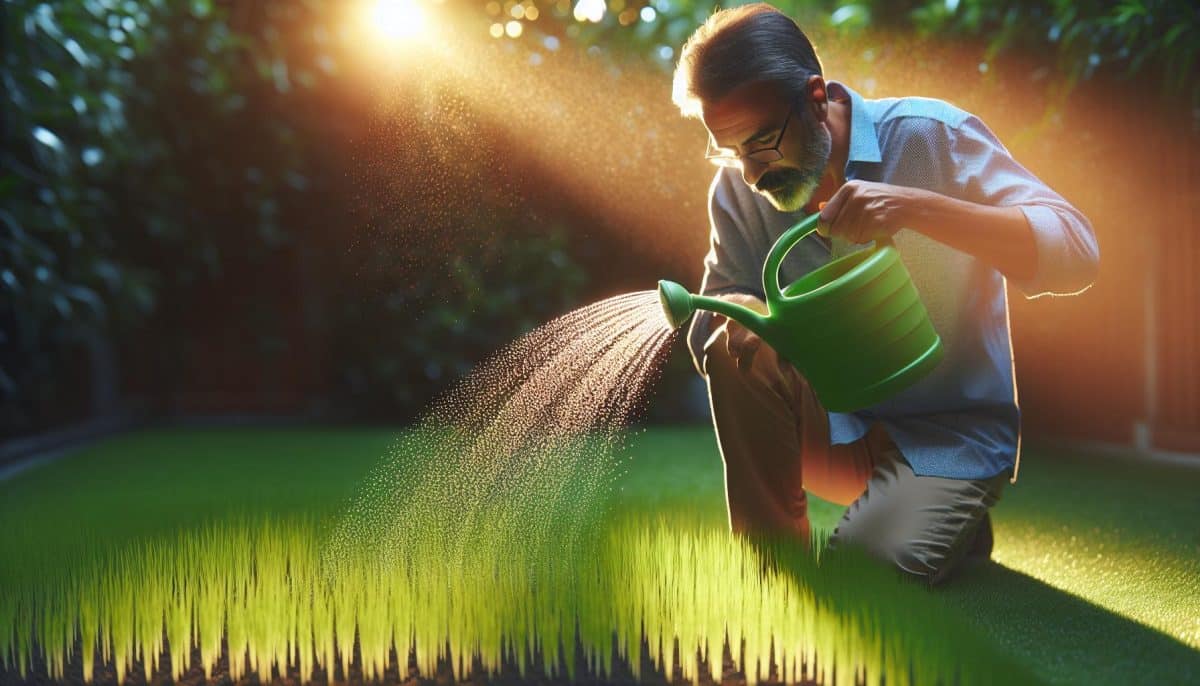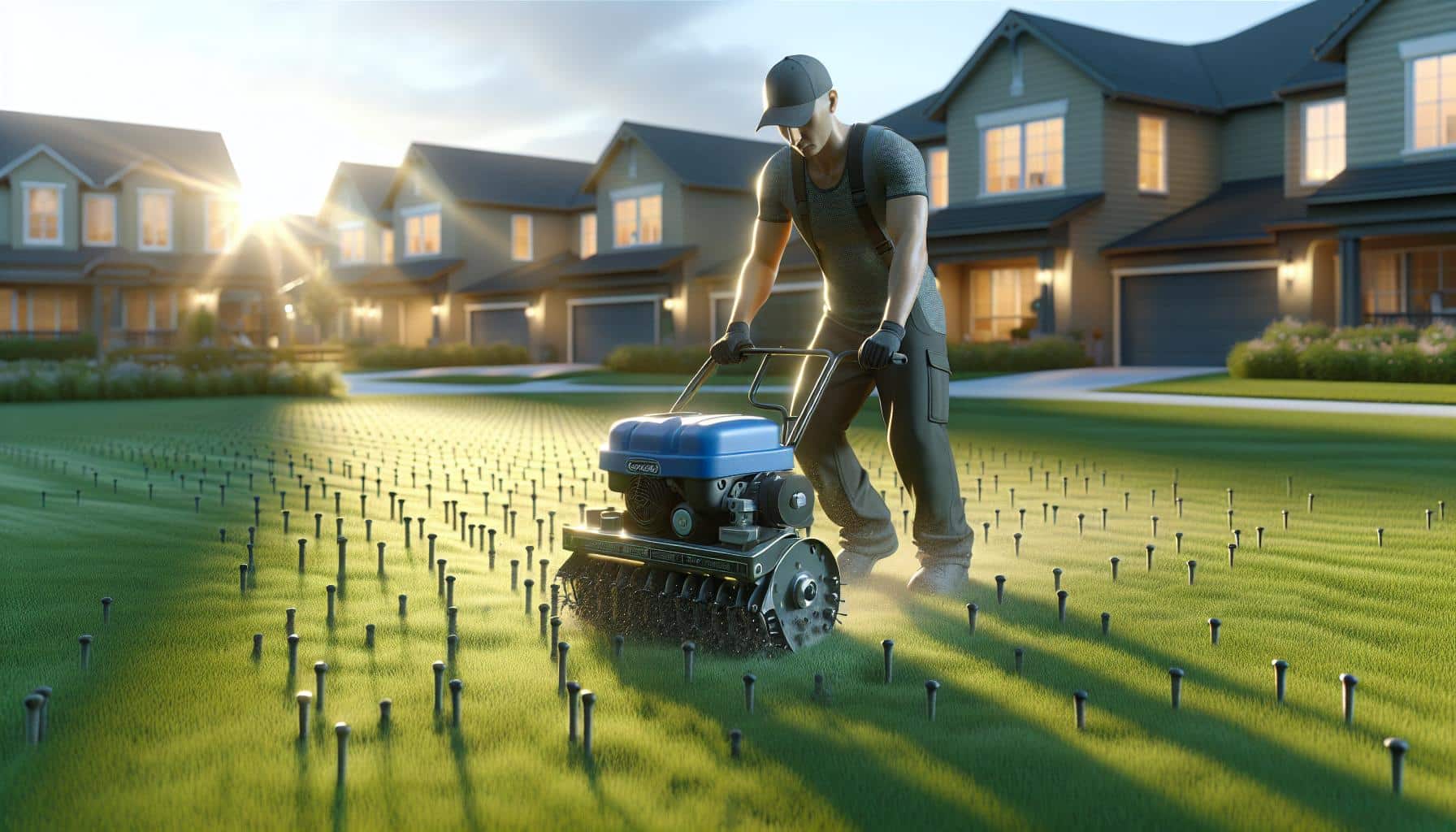
Facing a lawn that’s more weeds than grass can be disheartening, especially when your neighbour’s yard is the epitome of green bliss. It’s a common plight, but fear not—reseeding your lawn is a straightforward solution to revive its former glory. Understanding the right approach to reseed your lawn is crucial, as it’s not just about scattering seeds and hoping for the best.
Choosing the right time and the right type of grass seed for your climate is the first step towards a lush lawn. Whether you’re dealing with cool-season grasses in the Northeast or warm-season varieties in the South, getting it right means your lawn will not only grow but thrive. Let’s jump into how you can transform your yard into the green oasis you’ve been dreaming of.
Benefits of Reseeding Grass Seed
Reseeding your grass, often known as overseeding, extends beyond mere aesthetics. It’s a vital practice that bolsters your lawn’s health and resilience against various strains.
Firstly, reseeding enhances lawn density. Over time, older grasses thin out or die, creating gaps where weeds can thrive. Introducing new seeds fills these gaps, pushing out unwanted growth and cultivating a thick, lush lawn. This denser grass not only looks better but also establishes a stronger frontline defense against pest invasions and diseases.
Another critical benefit is improved grass variety. By selecting superior or more suitable grass seeds for your region, you can adapt your lawn to better withstand local climatic conditions, whether it’s extreme heat, cold, or drought. This strategic choice ensures that your lawn remains vibrant and green throughout the year.
Reseeding also plays a pivotal role in enhancing your lawn’s durability. New grass varieties often come with improved resistance to stress, wear, and damage. Whether it’s foot traffic from playing children or pets, or environmental stressors like harsh weather, a freshly seeded lawn is more capable of recovery and maintaining its integrity.
Finally, this practice significantly reduces maintenance efforts. A robust, well-established lawn requires less watering, fertilizing, and weeding. By investing time in reseeding, you’re setting the stage for a garden that thrives more independently, saving you time and resources in the long run.
When to Reseed Grass Seed

Reseeding, or overseeding, is an integral part of maintaining a verdant and healthy lawn. Understanding the timing and recognising the tell-tale signs that your lawn needs this care is crucial for effective lawn management.
Optimal Timing for Reseeding
Cool-Season Grasses: For those living in areas where cool-season grasses thrive, such as the Northeast and Pacific Northwest, the best time to reseed is during the fall. September’s conditions, with its cooler temperatures and heavier dew, provide an ideal setting for seed germination and root establishment. This period allows grass seeds to benefit from less competition with weeds and enjoy the upcoming winter’s moisture.
Warm-Season Grasses: In contrast, if your lawn consists of warm-season grasses common in the southern parts of the United States, early summer is the optimal reseeding time. This timing ensures that the soil is warm enough to encourage germination, but the full intensity of summer heat hasn’t yet arrived, which could stress young seedlings.
Key Takeaways:
- Reseed cool-season grasses in early fall.
- For warm-season grasses, early summer is ideal.
- Aim for periods of moderate weather, avoiding the hottest or coldest extremes for your grass type.
Signs Your Lawn Needs Reseeding
Monitoring your lawn’s health and appearance is essential for timely reseeding interventions. Below are indicators that suggest it’s time to reseed:
Thin or Bare Patches: Noticeable thinning or the presence of bare spots across your lawn is a clear sign that your grass struggles to sustain itself, making it a prime candidate for reseeding.
Discoloration and Uniformity: If your lawn loses its vibrant green hue or shows uneven areas of growth and color, it could be due to grass aging or disease, indicating the need for overseeding to reintroduce healthy growth.
Weed Infestation: A significant increase in weeds can suggest that your grass isn’t dense enough to suppress unwanted plants. Reseeding can improve lawn density, thereby reducing the room available for weeds to establish.
Increased Maintenance: When you notice your lawn requires more water, nutrients, or pest control than usual, it may be overcompensating for declining health and vitality. Introducing new, vigorous grass seed through reseeding can alleviate some of these demands by enhancing the lawn’s natural resilience.
After Disturbance or Damage: Lawns that have undergone stress from events such as heavy foot traffic, pet damage, or weather extremes often benefit from reseeding to repair and restore their lush appearance.
Recognising the optimal timing and signs for reseeding your lawn ensures that your efforts in lawn care are both effective and rewarding. Always choose a grass seed that matches your climate and existing lawn to promote success in your reseeding endeavors.
How to Prepare Your Lawn for Reseeding

Preparing your lawn for reseeding is a critical step to ensure healthy growth and beautiful results. Whether your lawn has suffered from wear and tear or you’re looking to improve its overall appearance, careful preparation is key. The process involves a few essential steps, starting with lawn mowing and dethatching, followed by soil testing and preparation.
Lawn Mowing and Dethatching
Before you can begin the reseeding process, your lawn must be in the right condition to accept new seeds. The first step is to mow your grass to a lower height than usual, aiming for approximately 25mm in length. This height is optimal because it allows sunlight, water, and nutrients to reach the soil more effectively, which in turn benefits the germination of new seeds.
After mowing, the next step is dethatching. Thatch is a layer of dead grass, roots, and debris that accumulates on the surface of the lawn over time, impeding water and nutrient penetration. Dethatching is essential for removing this barrier. Use a rigid tine rake to rigorously remove all the dead grass and weeds. This process not only clears the way for new seeds but also stimulates the underlying soil, making it more receptive to the new grass seeds you’re about to sow.
Soil Testing and Preparation
Having a healthy soil base is paramount for the successful germination of grass seeds. Start by conducting a soil test to determine your soil’s pH levels and nutrient profile. Knowing your soil’s condition allows you to address any deficiencies before reseeding. Most grass types thrive in a slightly acidic to neutral pH (about 6.0 to 7.0). If your soil tests outside of these levels, you may need to amend it accordingly with lime (to raise pH) or sulfur (to lower pH).
Soil preparation doesn’t stop with adjusting the pH levels. It’s also about creating the ideal texture for seeds to take root. Amend your soil with organic matter or a recommended soil conditioner to improve its structure. This step is crucial for facilitating proper drainage and aeration, providing the perfect bed for grass seeds to flourish.
For areas with compacted soil, consider aerating your lawn. Aeration involves creating small holes in the soil, allowing air, water, and nutrients to penetrate the root zone. This process is highly beneficial before reseeding as it encourages deeper root growth and improves seed-soil contact.
To finish the preparation, lightly moisten the soil without making it waterlogged. This ideal moisture level provides a nurturing environment for the new seeds to germinate and establish roots efficiently.
By carefully mowing and dethatching your lawn, followed by thorough soil testing and preparation, you lay the foundation for successful reseeding. This groundwork not only enhances the conditions for grass seed germination but also supports the health and beauty of your lawn in the long term.
Methods of Reseeding Grass Seed

When your lawn starts to show signs of wear and tear or thinning areas, reseeding becomes a crucial step to bring it back to its lush and vibrant condition. There are different methods to reseed your lawn, and choosing the right one depends on the current state of your lawn and the results you’re aiming to achieve.
Overseeding vs. Renovation
Overseeding is the process where you add new grass seed to an existing lawn without tearing up the lawn or soil. It’s ideal for lawns that are generally healthy but have some areas that are thin or a bit bare. Overseeding helps in filling those patches and increases the density of the grass, enhancing your lawn’s overall health and appearance. The key to successful overseeding is to ensure good seed-to-soil contact, as it encourages better germination rates and seedling growth. This method is less labor-intensive compared to renovation and can be executed with simple tools like a lawn mower, rake, and a seed spreader.
On the other hand, Renovation involves a more thorough approach and is considered when your lawn is heavily damaged or overrun with weeds. Lawn renovation may include killing off the existing vegetation, tilling the soil, adding soil amendments, and then reseeding. This method is more time-consuming and requires more effort but is necessary for lawns that need a complete overhaul. Renovation gives you the opportunity to address issues such as soil compaction, poor drainage, and the pH level of the soil, creating an ideal environment for new grass seed to take root and flourish.
Choosing the Right Grass Seed
Selecting the appropriate grass seed is pivotal for the success of your reseeding project. The choice of grass seed depends on several factors, including your lawn’s current grass type, climate, and the amount of sunlight your lawn receives.
For lawns with cool-season grasses, opt for a seed mix that thrives in cooler temperatures and has the resilience to bounce back from cold winters. Choices might include Kentucky Bluegrass, Fine Fescue, or Perennial Ryegrass. These varieties are known for their ability to establish quickly and provide a dense, vibrant green cover.
If your lawn consists of warm-season grasses, your selection should include species that perform well in hotter climates and can tolerate periods of drought. Options include Bermuda Grass, Zoysia Grass, or Centipede Grass. These species are excellent for creating a thick, durable lawn that can withstand the heat and occasional foot traffic.
Also, it’s vital to consider the sunlight exposure of your lawn. Grass seeds are labelled for full sun, shade, or partial sun/shade. Make sure to choose a seed mix that matches your lawn’s exposure to ensure optimal growth and development.
Tips for Successful Reseeding

Embarking on the reseeding journey for your lawn is an endeavour that promises lush, green rewards if approached with the right knowledge and tools. This guide dives into the critical aspects of proper watering and maintenance post-reseeding to ensure your efforts flourish.
Proper Watering and Maintenance
Initial Watering is Key. After spreading the seeds, your first task is to establish a diligent watering routine. The soil should be kept consistently moist but not waterlogged, as too much water can cause the seeds to wash away or rot. An ideal approach is to water lightly but frequently, up to two to three times daily, especially in the initial weeks post-seeding. This helps the seeds to germinate effectively and ensures young grass shoots do not dry out and perish.
Graduate to Less Frequent, Deeper Watering. Once you notice the seeds sprouting and establishing themselves, it’s crucial to gradually reduce the frequency of watering but increase the amount each time. This encourages the roots to grow deeper into the soil, seeking moisture, which in the long run cultivates a more drought-resistant lawn. Typically, transitioning to watering once every two or three days with a heavier flow aids in fostering robust root systems.
Address the Competition: Weeds and Thatch. Post-reseeding, your lawn is in a vulnerable state, vying for nutrients, water, and sunlight. It’s essential to manage weeds proactively, as they compete for these same resources. But, caution is advised with herbicides; always opt for products safe for young grass and consider spot treatment to minimize harm. Thatch build-up, a layer of dead grass and organic matter, should be monitored and controlled. Aeration can be highly beneficial in this phase, promoting oxygen, water, and nutrient flow to the roots.
Feed Your Lawn Appropriately. Choosing the right fertilizer for the new grass is pivotal. Start with a starter fertilizer enriched with phosphorus to aid root development when you sow the seed. As the lawn matures, switch to a nitrogen-rich formula to support leaf growth. Always follow the manufacturer’s instructions to avoid over-fertilization, which can damage your newly sprouting grass.
Conclusion
Reseeding your lawn is a rewarding endeavour that transforms your outdoor space. Remember, the key to lush, vibrant grass isn’t just in the sowing but in the aftercare. By ensuring you’re watering lightly but frequently at first and then adjusting to deeper, less frequent watering, you’re setting your lawn up for success. It’s also vital to stay on top of weed and thatch management while being mindful of the fertilisers you use. With patience and the right care, your reseeded lawn will not only grow but thrive, becoming a testament to your gardening prowess. Keep these tips in mind, and you’ll enjoy a beautiful, resilient lawn that’s the envy of the neighbourhood.
Colin Macmillan is a seasoned entrepreneur and the CEO of Riverwood Landscape, a leading landscaping company based in Canada. He has been at the helm of the company since leaving high school, demonstrating his strong leadership skills and business acumen.
Colin’s expertise lies in various aspects of landscaping, including lawn care, interlocking, sod installation, and commercial maintenance. His hands-on approach and dedication to the craft have been instrumental in building Riverwood Landscape into a reputable brand.
One of his most notable achievements is the creation of a successful landscape franchise that services multiple locations. This accomplishment underscores his strategic thinking and ability to scale operations effectively.
Colin has also had the privilege of working with Guelph Hospital for landscaping and maintenance, a testament to the trust and reliability that his company has earned over the years.
His professional mission is to offer the best services and experiences for customers, a goal that he tirelessly pursues. Colin’s commitment to excellence and customer satisfaction continues to drive the growth and success of Riverwood Landscape.








